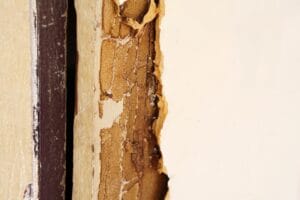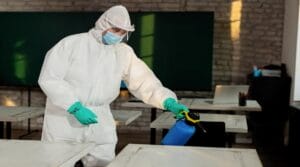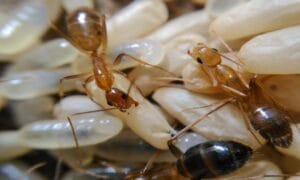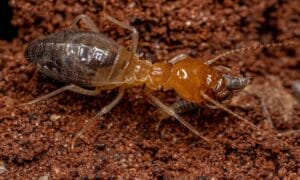Termites are no joke. They’re silent, they’re destructive, and before you know it, they can cause serious damage to your home. But you’re not powerless against these wood-munching menaces. With the right knowledge and tools, you can take a stand. Let’s dive into the essentials of DIY termite control – its effectiveness, risks, and how you can prevent these pests from taking over your space.
Key Takeaways
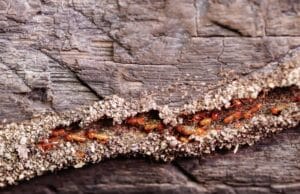
- Regular inspection of your home’s foundation and wooden structures is crucial for early detection of termites.
- DIY termite control can be effective if done correctly, but understanding termite behavior is key.
- Some common DIY methods, like commercial sprays, may not have the strength to eliminate termites and could pose risks to your health and environment.
- Professional-grade termite treatments are available for homeowners, but proper application is necessary for safety and effectiveness.
- Preventative measures, such as reducing moisture and eliminating wood-to-ground contact, are essential in keeping your home termite-free.
Spotting the Early Signs of Termites
When it comes to termites, the early bird catches the worm – or in this case, the termite. Vigilance is your first line of defense. Keep an eye out for mud tubes along your foundation, wood that sounds hollow when tapped, and frass – that’s a fancy term for termite droppings. These are telltale signs that you might have some unwanted guests.
What to Look For Around Your House
Most importantly, don’t wait for termites to make themselves known. They’re shy critters. Regularly inspect the perimeter of your home, paying special attention to the foundation, windows, and door frames. Look for changes in the wood and any signs of disturbance in the soil. If you see anything suspicious, it’s time to take action.
Termites love moisture, so check for leaky pipes and water damage. These areas are like a termite magnet. Because termites can be hard to spot, you might need to play detective. Tap on wood structures – if they sound hollow, termites might be the culprits. Also, keep an eye out for their wings. Termites shed their wings when they swarm, so finding these little wing piles can be a big red flag.
Understanding Termite Behavior
Termites aren’t just eating your wood for fun. They’re doing it to survive. And they’re really good at it. They prefer dark, humid environments and will go out of their way to avoid light. This means they’ll often build their nests underground and find ways to your wood through tunnels. By understanding their behavior, you can better predict where they might be hiding and how to stop them.
DIY Termite Treatment Myths Busted
Now, let’s clear up some misconceptions. The internet is rife with DIY termite treatment myths that can do more harm than good. You might read about solutions like orange oil or vinegar as termite treatments. While these might repel some pests, they’re not going to cut it for a termite infestation.
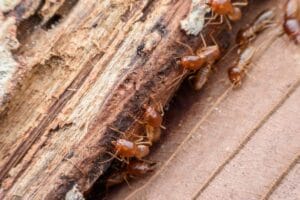
- Orange oil is often touted as a natural termite killer, but it’s only effective on contact and won’t eliminate a colony.
- Vinegar might kill some termites on the surface, but it doesn’t address the root of the problem – the nest.
DIY treatments might seem like a cost-effective solution, but they can end up costing you more in the long run if they don’t work. And often, they don’t. Termites are resilient. If you don’t hit them hard and at the source, they’ll keep coming back.
The Truth About Common Household Remedies
Let’s talk about the remedies you might find around the house. Some folks swear by borax powder or essential oils to combat termites. While these might have some effect on individual termites, they’re unlikely to resolve an infestation. The truth is, termites are tough. They have large, complex colonies, and getting rid of them often requires more than just a sprinkle of powder or a spritz of oil.
Why Some DIY Methods Fail
Here’s the thing: termites are not a one-spray-and-done kind of problem. They build extensive colonies, and if you’re not treating the whole colony, you’re just putting a Band-Aid on a broken leg. DIY methods often fail because they don’t get to the heart of the infestation – the queen and her nest. Without professional-grade products and a comprehensive treatment plan, you’re likely just scratching the surface.
The Right Way to Do Termite Control Yourself
So, you’ve decided to tackle termites on your own. Good for you! But before you get started, let’s make sure you’re doing it the right way. First off, identify the type of termite you’re dealing with. Different species may require different approaches. Next, arm yourself with the right products. Look for treatments that are specifically designed for the type of termites in your home. And remember, always follow the instructions to the letter. Safety first!
Option A.
Tips for Applying DIY Termite Products
Applying DIY termite products can be straightforward if you follow these steps:
- Always wear protective gear, like gloves and a mask, to avoid contact with chemicals.
- For liquid treatments, dig a trench around your home’s foundation and apply the termiticide according to the product’s directions.
- Place bait stations near termite activity but away from areas where children and pets play.
- Monitor the bait stations regularly and replenish the bait as needed.
- Be patient – it can take several weeks or even months for bait stations to fully eradicate a colony.
Remember, consistency is key. You need to maintain your termite control efforts to ensure success.
Potential Dangers of Home Termite Control
While DIY termite control can be effective, it’s not without its risks. Chemical treatments, if not handled properly, can be hazardous to your health and the environment. It’s essential to understand the potential dangers before you begin.
Chemical Safety and Handling
Chemicals used in termite control can be toxic. Therefore, it’s critical to handle them with care. Always read the label for proper usage instructions and safety precautions. Store chemicals in a secure place, away from children and pets, and dispose of any unused product according to local regulations. If you spill a chemical, clean it up immediately and avoid contaminating water sources.
Moreover, if you’re not confident in your ability to safely apply these treatments, it might be time to call in the professionals. There’s no shame in ensuring your and your family’s safety.
When to Call the Professionals
If you’re dealing with a large infestation, if the DIY treatments you’ve tried aren’t working, or if you’re unsure about the safety of applying chemicals yourself, it’s time to call the pros. They have the expertise, equipment, and access to more potent treatments that can resolve your termite troubles effectively and safely.
Professional pest control services can also provide guarantees and follow-up treatments, giving you peace of mind that the problem is truly taken care of.
Preventing Future Termite Problems
The best way to fight termites is to prevent them from showing up in the first place. After you’ve dealt with an infestation, take steps to make your home less inviting to termites.
Maintaining A Termite-Free Home

Here are some ways to maintain a termite-free home:
- Reduce moisture around your home by fixing leaks and ensuring proper drainage.
- Keep firewood, mulch, and other cellulose-based materials away from your home’s foundation.
- Regularly inspect your home for signs of termites, especially if you live in an area prone to infestations.
By staying vigilant and keeping conditions around your home unfavorable for termites, you can greatly reduce the chances of another infestation.
Year-Round Termite Prevention Measures
Termites don’t take a break, so neither should your prevention efforts. Seal up cracks and crevices in your home’s exterior to block entry points. Use termite-resistant materials for any new construction or repairs. And consider an annual inspection by a termite professional to catch any potential problems early.
Remember, prevention is always easier and less expensive than treatment.
Top Termite Control Products for Homeowners
There are several termite control products on the market that are suitable for homeowner use. Let’s explore some of the best options available.
Best Bait Stations and How to Use Them
Bait stations are a popular choice for DIY termite control. Some of the best include:
Option A.
Top Liquid Termiticides on the Market
Liquid termiticides create a barrier that prevents termites from entering your home. Some of the top products include:
- Termidor: Highly effective and long-lasting, Termidor can only be applied by licensed professionals but is considered the gold standard in termite treatments.
- Taurus SC: This is a generic version of Termidor that offers similar effectiveness at a more affordable price and is available for homeowner use.
When applying liquid termiticides, follow the label instructions carefully. Typically, you’ll need to dig a trench around the perimeter of your home and apply the product into the soil to create a barrier.
Whether you choose bait stations or liquid treatments, make sure you’re using them correctly and safely. And if you’re ever in doubt, don’t hesitate to reach out to a termite control professional for advice.
When DIY is Not Enough: Seeking Professional Help
DIY termite control has its place, but sometimes the situation calls for professional intervention. If you’ve tried DIY methods and the termites are still thriving, or if the infestation is too large to handle on your own, it’s time to call in the experts.
Professional pest control services can assess the extent of the infestation, recommend a treatment plan, and provide the peace of mind that comes with knowing the problem is being handled by someone with the right skills and tools.
Dealing with termites can be daunting, but with the right approach, you can protect your home from these destructive pests. Whether you choose to go the DIY route or bring in the professionals, the key is to act quickly and decisively to prevent damage to your property.
Signs You Need to Call in the Pros
It’s important to know when you’re out of your league with termite control. Here are some clear signs that it’s time to call in the professionals:
- Swarmers inside your home, which are young winged termites ready to start new colonies.
- Visible damage to wooden structures, including tunnels and galleries within the wood.
- Termite mud tubes on exterior walls, which termites use to travel and protect themselves from predators and dry environments.
- A severe infestation that persists despite your best DIY efforts.
- Lack of confidence in handling potent chemicals or if the infestation is in hard-to-reach areas.
If you’re experiencing any of these issues, professional termite control services can offer the expertise and resources needed to effectively tackle the problem.
What to Expect During Professional Termite Treatment
Professional termite treatments involve a thorough inspection of your property, identification of the termite species, and a tailored treatment plan. Professionals may use a combination of methods such as soil treatments, bait stations, and wood treatments to address the infestation. They’ll also provide advice on preventing future infestations and may offer maintenance plans for ongoing protection.
Frequently Asked Questions
Can I Eliminate Termites Permanently on My Own?
Eliminating termites on your own is challenging and often not permanent. While DIY methods can provide temporary relief, complete eradication usually requires professional treatment due to the hidden and extensive nature of termite colonies.
Are Over-The-Counter Termite Treatments Safe for Pets and Children?
Many over-the-counter termite treatments can be safe when used according to the label’s instructions. However, it’s essential to choose pet and child-safe options and to apply them carefully, ensuring that areas are properly ventilated and that baits and chemicals are out of reach. For more detailed guidance, consider reading about the pros and cons of DIY termite control.
How Often Should I Inspect My Home for Termites?
It’s wise to inspect your home for termites at least once a year. In regions with higher termite activity, more frequent inspections—every six months or even quarterly—may be necessary.
Do DIY Termite Treatments Affect the Value of My Home?
DIY termite treatments, if effective, can protect your home’s value by preventing damage. However, evidence of DIY treatment without professional follow-up could raise concerns for potential buyers. It’s often best to have professional treatments and inspections documented to reassure future buyers.
Can Termites Return After a Professional Treatment?
Yes, termites can return after professional treatment, especially if conducive conditions remain or if the treatment barrier breaks down over time. Regular inspections and maintenance treatments are essential to keep termites at bay.
DIY termite control can be a tempting option for homeowners looking to save money. However, it’s important to understand the potential risks and effectiveness of this approach. Without professional help, you might not be able to fully eradicate the termite problem, and improper use of pesticides can be dangerous.
